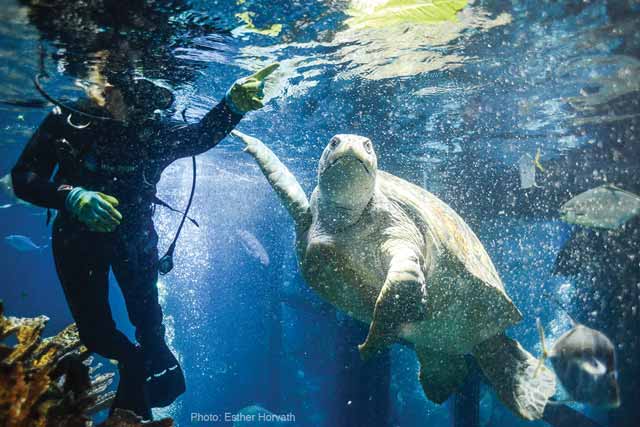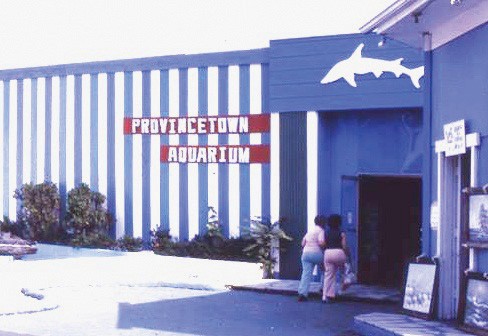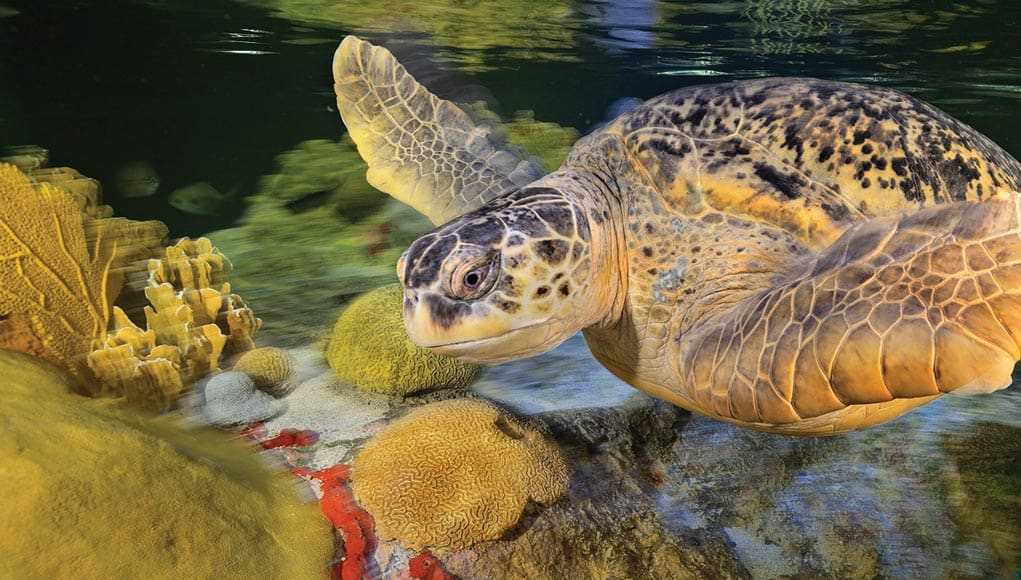by Steve Desroches
There are lots of famous folks who came through Provincetown before they hit the big time. Tennessee Williams. Lily Tomlin. Cassandra Peterson, prior to becoming Elvira, Mistress of the Dark. But Provincetown as a springboard to celebrity isn’t limited to just people, but also the animal kingdom. Myrtle the Turtle is the 500-plus-pound, undisputed queen of the Giant Ocean Tank at the New England Aquarium in Boston, and she has become a beloved icon since arriving there from Provincetown 50 years ago. Estimated to be 70 to 90 years old, she is the grand dame of the marine turtle world.
“Myrtle is unlike any other turtle,” says Mike O’Neill, supervisor of the 200,000-gallon Great Ocean Tank at the Aquarium. “I’m optimistic she’ll live to be over 100.”
Myrtle the Turtle’s beginnings appear to be lost to the misty, water-colored memories of the way Provincetown was. In 1964 the old Paige Brothers Garage was transformed into the Provincetown Marine Aquarium. Now home to favorite to-go eateries like Big Daddy’s Burritos, Fortune Cookie, and I Dream of Gelato, the brick building was home to a variety of sea creatures educating visitors about local marine life. The reminder of what it had once been is the name: the Aquarium Marketplace. Where the Aqua Bar now stands is the former site of a large tank where three Atlantic bottlenose dolphins – Jackie, Lady, and Lucky – wowed the 40,000 visitors that came through the aquarium in its first year alone. Only a seasonal attraction, each fall the tanks were emptied and most of the sea creatures returned to the ocean, while the dolphins were transported to the Dolphin Research Center in Grassy Key, Florida, and those that could stand the cold winter weather, like sea lions and penguins, stayed to the delight of year-round residents. At some point during the 1960s two green sea turtles arrived at the Provincetown Marine Aquarium: Barnacle Bess and Myrtle the Turtle. In 1969 both turtles went to the newly opened New England Aquarium on Central Wharf in Boston, with plans to return to Provincetown in the spring. But Myrtle never returned. Instead she moved into the Giant Ocean Tank, which opened in 1970. (There is no record of what happened to Barnacle Bess).

When Myrtle arrived at the New England Aquarium she weighed in at 225 pounds and quickly gained more weight, topping off at 300 pounds her first year in Boston. To the many scientists and veterinarians that have studied and cared for her over the years, her weight upon arrival signifies to them she was a mature turtle and that she was anywhere from 20 to 40 years old as that is the age range a green sea turtle becomes sexually mature. There is scant information on Myrtle’s pre-Boston years, but having been there for 50 years, that makes her the oldest known sea turtle in captivity. And considering she is quite pampered in the Great Ocean Tank, being well fed with no risk from predators or boat strikes, she should live decades more. That longevity has made her an icon to the generations of visitors to the New England Aquarium, as she’s been there from the very beginning.
“She definitely gets noticed just by her size alone, so that in part makes her popular,” says O’Neill. “She’s especially popular with children. On a daily basis you can hear children yell out, ‘Look at that!’ Adults bring their children to the aquarium to see Myrtle because they remember her from when they were young.”
Myrtle consistently gets fan mail, too, from her young admirers. And at the risk of anthropomorphizing her, it seems that perhaps all of this attention has gone to Myrtle’s head; aquarium staff lovingly call her a “diva” and a “prima donna.” A curious creature by nature, Myrtle investigates every new arrival in the tank, human or otherwise, as well as any other noises. If ever a staff member is scuba diving in the tank to make repairs or check on another animal, another diver must be in the tank to distract Myrtle or she will be relentless in her quest for attention, bumping into said diver until they finally scratch the back of her shell.
Green sea turtles are grazers, always on the hunt for food, so Myrtle is always ready to chow down. Mostly herbivores, she particularly likes brussels sprouts, kale, and cabbage, with the occasional squid or shellfish. While she has a voracious appetite, she can be finicky. While other turtles gobble most everything, Myrtle occasionally makes her dislikes known, like the time she spit out bell peppers when a handler tried to introduce something new to her diet. And then there is her size. She is the largest creature in the Great Ocean Tank, so everything moves out of the way for Myrtle. And if they don’t? She makes her displeasure clear. There are two loggerhead turtles in the tank; one is blind and the other has a neurological disorder, so at times they swim in Myrtle’s way, at which point she gives them a strong shove with one of her flippers, tossing them out of the way.

“She’s every bit the queen of the tank,” says Kathy Streeter, curator of marine mammals at the New England Aquarium. “Pretty much what Myrtle says goes. She calls the shots.”
It turns out that Myrtle is not only assertive, but smart. Streeter worked with Myrtle as part of a project funded by the United States Navy and the University of Maryland, College Park from 1997 to 2004 to study the hearing of sea turtles, and in particular if the low frequencies used by the Navy would harm them. Conventional wisdom of the time said sea turtles were not trainable. But Streeter and Myrtle proved that to not be true. Myrtle without a doubt responded to the study with particular response behavior to different sounds and stimulations. She also proved to have a good memory as months would pass, but if a certain sound was made or item appeared in the tank she would respond with the desired behavior. As it turns out, the frequencies used by the Navy did not harm turtles. For that study, and the many others she’s been part of over the years, it’s hard to find another turtle anywhere in the world that has taught scientists more about the species.
Indeed, Myrtle has something to teach us all. Sea turtles live in most places in the world, preferring water 70 degrees or warmer. And they make their way into the waters off Cape Cod every summer, sometimes getting caught in an early autumn cold snap and washing up on beaches to be rescued by organizations like the Aquarium and Mass Audubon. But climate change and other human behaviors are threatening sea turtles, especially plastic waste in the ocean and light pollution along the coast, which disorients and confuses turtles when they come ashore to lay eggs. In the best of scenarios, of the estimated 100 eggs a turtle lays, only one will live to maturity. The odds dip for the species when other factors are considered. So what can be done? O’Neill says the best we can do is be good stewards of the Earth by reducing plastic use and supporting conservation and wildlife protections, as well as sustainable fishing practices.
“And vote,” says O’Neill. “Vote with the environment in mind. Make it known that you are an environmental voter. Myrtle will live a good long life. I hope and believe she’ll still be here when I retire in a couple of decades. But to save animals like her we need to vote accordingly.”
Anyone with any information regarding Myrtle’s Provincetown years is encouraged to contact the New England Aquarium. For more information call 617.973.5200 or visit neaq.org.











